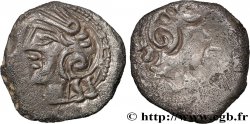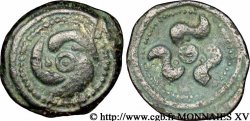v15_0839 - GALLIA BELGICA - LINGONES (Area of Langres) Bronze aux trois poissons
MONNAIES 15 (2002)
Starting price : 250.00 €
Estimate : 500.00 €
unsold lot
Starting price : 250.00 €
Estimate : 500.00 €
unsold lot
Type : Bronze aux trois poissons
Date: c.80-50 AC.
Metal : bronze
Diameter : 19,5 mm
Orientation dies : - h.
Weight : 3,29 g.
Rarity : R3
Coments on the condition:
Très bel exemplaire pour ce type rarissime. Patine verte
Catalogue references :
Obverse
Obverse legend : ANÉPIGRAPHE.
Obverse description : Trois poissons autour d’un annelet pointé ; grènetis et bourrelet.
Reverse
Reverse legend : ANÉPIGRAPHE.
Reverse description : Trois S (hippocampes) autour d’un annelet pointé ; grènetis et bourrelet.
Commentary
Certains affirment qu'il s'agit bien de monnaies coulées, argumentant, entre autres, avec la finesse des potins du type MONNAIES XV, n° 1274-1276. Techniquement, nous persistons à penser qu'il s'agit de monnaies frappées. Les potins sont caractéristiques avec leur bourrelet périphérique. Sur ces exemplaires en bronze, ce sont les traces du bord des coins qui sont visibles (tant au droit qu'au revers). D'un mauvais ajustage des moules, pour couler un potin, résulte des barbes de métal et deux côtés complets, mais partiellement sur une demi-épaisseur. En ce qui concerne les monnaies frappées, le flan reste le même, régulier, ce sont les empreintes des coins qui sont décalées si la frappe n'est pas ajustée au flan.
Some claim that these are cast coins, arguing, among other things, with the fineness of the potins of the type COINS XV, n° 1274-1276. Technically, we persist in thinking that these are struck coins. The potins are characteristic with their peripheral bead. On these bronze examples, it is the traces of the edge of the dies that are visible (both on the obverse and the reverse). A poor adjustment of the molds, to cast a potin, results in metal beards and two complete sides, but partially on a half-thickness. As for the struck coins, the flan remains the same, regular, it is the impressions of the dies that are offset if the strike is not adjusted to the flan
Some claim that these are cast coins, arguing, among other things, with the fineness of the potins of the type COINS XV, n° 1274-1276. Technically, we persist in thinking that these are struck coins. The potins are characteristic with their peripheral bead. On these bronze examples, it is the traces of the edge of the dies that are visible (both on the obverse and the reverse). A poor adjustment of the molds, to cast a potin, results in metal beards and two complete sides, but partially on a half-thickness. As for the struck coins, the flan remains the same, regular, it is the impressions of the dies that are offset if the strike is not adjusted to the flan








 Report a mistake
Report a mistake Print the page
Print the page Share my selection
Share my selection Ask a question
Ask a question Consign / sell
Consign / sell
 Full data
Full data















